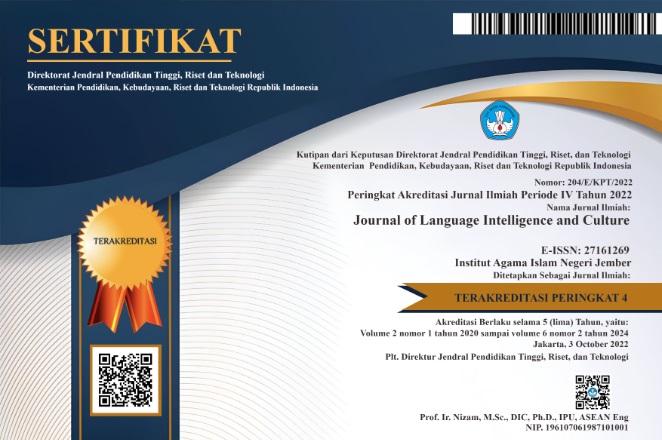The Development of Learning Media “E-Writing” to Develop Students’ Writing Skill of English Education Department
DOI:
https://doi.org/10.35719/jlic.v2i2.31Keywords:
Media E-Writing, Writing Skill, Media DevelopmentAbstract
This study aimed at developing an appropriate electronic learning media named E-Writing to improve students’ writing skill of English Education Department. This media will be the solution of students’ difficulties in writing activities especially as a guidence for writing task and activities. That is why this research is going to develop a media which based on the needs of analysis to make the learning process of writing skill become effective. This research is developed based on the Design and Development (D&D) model. The data obtained from the experts’ evaluation result. All data are both analyzed qualitatively and quantitatively using mean score and alpha Cronbach formula. The result of this study suggested that E-Writing can be such a beneficial media for students’ writing development.
References
Alyani, Rochana. 2016. Developing Writing Materials by Using Genre-Based Approach for the First Semester Of The Tenth Grade Students At Sma Piri 1 Yogyakarta. Universitas Negeri Yogyakarta
Baoan. 2008. Application of Popular English Songs in EFL Classroom Teaching. HLT Magazine and Pilgrims. Year 10; Issue 3; June 2008, ISSN 1755-971
Barr Ebest, Sally. Changing the Way We Teach: Writing and Resistance in the Training of Teaching Assistants. Carbondale: Southern Illinois UP, 2005
Bates, Anthony. 2012. Choosing and Using Media in Education: The SECTIONS Model
Booker, Mayer. 2001. Elisitasi dan Analisis Pakar Borg, W. R. and Gall, M. D. 1989. Educational Research: An Introduction 5th. edn. NewYork: Longman.
Brewster, J., Ellis, G, &Girard, D. 2007. The Primary English Teacher’s Guide. Essex, England: Pearson Education Limited
Brown, H.D. 2004. Language Assessment: Principles and Classroom Practices. New York: Pearson Education
Brown, H.D. 2007. Teaching by Principles: An Interactive Approach to Language Pedagogy (3rd edition). New York: Pearson Longman
CCSU. 2016. Worlds Most Littered Nation Ranked.
Coger, R. 1975. Developing Effective Instructional Systems. U.S.A.: The Christopher Publishing House
Cole, Michael. Cole, Sheila.R & Lightfoot, Cynthia (2005). The Development of Children. New York: Worth Publishers
Conradie, P.J. 1977. Van Ondemghulpmiddel Tot Sisteemondenig. Durban: Butterworth
Ellis, TJ & Levy, Y. 2010. Panduan untuk Peneliti Novice: Desain dan Metode Penelitian Pengembangan. Prosedur Menginformasikan Pengawasan Ilmu Pengetahuan dan Ilmu Pengetahuan (InSITE)
E. Shelley Reid. 2009. Teaching Writing Teachers Writing: Difficulty, Exploration, and Critical Reflection
Fabon. 2013. Use Songs to Teach English as a Second Language in Primary School. Universidad de La Rioja, Servicio de Publicaciones
Gay, L. R. 1987. Educational Research: Competencies for Analysis and Application: 3rd.edn. London: Merrill Publishing.
Harmer, J. 2004. How to Teach Writing. Essex: Pearson Education
Heinich, R., Molenda, M & Russel, J.D. 1989. Instructional Media. London: Collier Macmillan
Helmer, Olaf. 1963. Penggunaan Pakar Pakar secara Sistematik dalam Riset Operasi
Jacobs, M., Gawe, N. & Vakalisa, N.C.G. 2002. Teaching-Learning Dynamics: A Participative Approach for OBE. 2nd edition. Johannesburg: Heinemann
Jafarian, K., Soori, A. & Kafipour, R. 2012. The Effect of Computer Assisted Language Learning (CALL) on EFL High School Students’ Writing Achievement. European Journal of Social Sciences. Vol.27
Langran, John & Purcell, Sue. 1994. Language Games and Activities. Netword 2. Teaching Languages to Adults. London: Center for Information on Language
Marquardt, M.J. 1999. Action Learning in Action: Transforming Problems and People for World-Class Organizational Learning. Boston: Davies-Black
Mayer, R.E. & Moreno, R. 2002. Aids to Computer-Based Multimedia Learning
Megarry, J., Walker, D.R.F., Nisbet, S. & Hoyle, E. 1983. World Yearbook of Education 198213, Computers and Education. London: Kogan Page Ltd
Patton, Quinn. 2003. Daftar Periksa Evaluasi Kualitatif
Rahardjito. Haryono, Anung. Rahardjo, R. dan Arief, S. Sadiman. 2008. Media Pendidikan: Pengertian, Pengembangan, dan Pemanfaatannya. Jakarta: PT Raja Grafindo Persada.
Reddi, U.V. & Mishra, S. 2003. Education Multimedia: A Handbook for TeacherDeveloper. New Delhi: The Commonwealth Educational Media Centre for Asia (CEMCA)
Reiser, A. Robert. 1996. Instructional Planning: A Guide for Teachers. USA: Library of Congress Catalog-in-Publication Data
Suhartono dan Laraswati. 2016. The Use of Visual Media in Teaching Writing. University of Nusantara PGRI Kediri
Vreken. An Introduction to Teaching-Learning Media. A Manual for Student Teachers
Wah, C.L. 2006. A Study of Students’ Perceptions and Attitudes Towards ESL Writing Using Computer-Based Learning Materials. Internet Journal of ELanguage Learning & Teaching. Vol. 3
Warschauer, M. 1996. Computer-Assisted Language Learning: An Introduction. In S. Fotos (Ed.), Multimedia Language Teaching (pp. 3-20). Tokyo: Logos International
Wening, Rahayu.2016. The Role of Picture Series in Improving Students' Writing Ability. International Conference on Education. Universitas Negeri Malang
Zhu, Zhuo. 2010. Applying Innovative Spirit to Multimedia Foreign Language Teaching. English Language Teaching. Vol. 3
Downloads
Published
How to Cite
Issue
Section
License
Copyright (c) 2020 Journal of Language Intelligence and Culture

This work is licensed under a Creative Commons Attribution-ShareAlike 4.0 International License.













